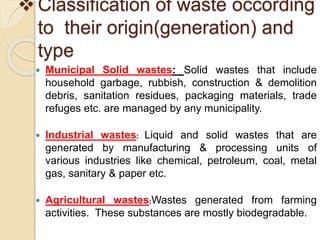Waste can be solid, liquid, or gaseous materials that are discarded after use. Solid wastes include domestic, commercial, and industrial trash like plastics, paper, and metal. Liquid wastes include sewage and wastewater from industrial processes. Wastes are also classified as biodegradable, non-biodegradable, hazardous, or non-hazardous. Improper waste disposal pollutes the environment and harms human health, causing issues like cancer, mercury poisoning, and increased greenhouse gases. The 3R approach of reduce, reuse, and recycle can help mitigate waste and promote more sustainable practices.























